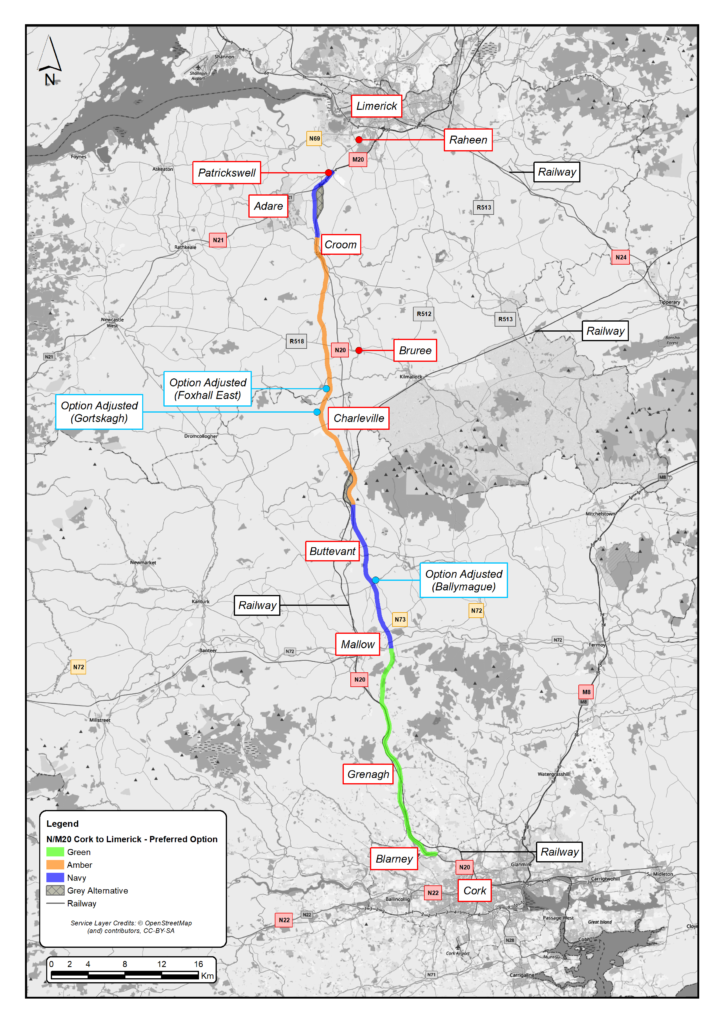31 March 2022
By Tom Collins
tom@TheCork.ie
Preferred Transport Solution for N/M20 Cork to Limerick announced
Details of the preferred transport solution for the N/M 20 Cork to Limerick project, identified as a priority investment in the Government’s National Development Plan 2021-2030, have been published.
80 kilometres of new and improved dual carriageway road between Cork City and Patrickswell, Limerick will address the existing road’s shocking safety deficiencies which contribute to a fatal collision rate four times the national average.
The road design, including cross-section, road type (Protected Road or Motorway), junction strategy and accommodation works will be developed during the next phase of the project, within the 500m wide preferred road-based option, published on www.CorkLimerick.ie
The preferred road-based option broadly follows the previous 2010 M20 Cork – Limerick scheme. Between 30% and 40% of the existing N20 road will be reused to develop the new dual carriageway.
Bypasses of Mallow, New Twopothouse, Buttevant, Charleville and Banogue will remove strategic traffic and heavy goods vehicles from these communities, significantly improving air quality, reducing noise levels, and further supporting public realm improvements, sustainable transport and vibrant communities.
The project will have a major impact on the attractiveness of public transport, achieving intercity journey time savings of up to 30 minutes for express bus services between Cork and Limerick and improving journey times and reliability for local bus services along the N20 corridor.
Additionally, the project examined a range of rail-based options and has recommended the development of a ‘no change’ additional hourly rail service between the two cities, via Limerick Junction, reducing intercity rail journey times by over 20 minutes between Cork and Limerick.
The new rail service is being recommended by the project team for consideration within the All Island Strategic Rail Review.
The project will deliver 80 kilometres of transformative active travel (walking and cycle) infrastructure, connecting together the communities of Cork, Blarney, Grenagh, Rathduff, Mallow, New Twopothouse, Buttevant, Charleville, Bruree, Banogue, Croom, Patrickswell and Limerick.
Both Cork Chamber and Limerick Chamber have welcomed the announcement.
Conor Healy, CEO of Cork Chamber commented,
“After over a decade highlighting the economic importance of this major project linking two of Ireland’s most progressive city regions, it is positive to see this progress and it represents another step towards the delivery of this project. The preferred multi-modal transport solution will encompass 80km of high-quality grade separated dual carriageway, a safe and segregated 80km active cycle and walking corridor as part of the Cork to Limerick Greenway, and enhanced public transport corridors provided via rail and bus services with additional and more frequent services.”
“This mixed-modal solution is essential to de-congesting and transforming towns along the route that typically see heavy and dangerous traffic conditions. Upon completion of the project, we can expect to witness greater connectivity between Cork, Limerick and Galway, an indispensable element to improving the region’s economic attractiveness to investment. It is vital to the success of the project that strategically placed ‘Park and Ride’ services and mobility hubs remain high on the agenda as the project progresses.”
“While public consultations will be held over the next two years, we will continue to keep our members informed with planned online briefings already in the pipeline. In the meantime, we urge Government to continue to support sustainable infrastructure projects that focus on economic and environmental resilience and to deliver on support for CMATS/LSMATS which are a huge part of the overall picture.”
Meanwhile, Ibec, “the group that represents Irish business” have commented also.
Ibec Head of Regional Policy Helen Leahy said:
“The proposed multi-modal transport solution will improve inter-urban and inter-regional connectivity and support ambitious growth targets for Cork and Limerick. An integrated transport system, with enhanced road, public transport and active travel infrastructure for walking and cycling, will offer many co-benefits in terms of health, reducing congestion, and facilitating more accessible and vibrant communities. The recommendation for an enhanced rail service via Limerick Junction complements the road upgrade. It makes economic sense given that the other, more costly rail options that were considered would offset bus rather than car travel between Cork and Limerick cities.
“It is vital that the road upgrade scheme progresses through the design stage and moves forward to planning with urgency. The existing N20 route faces ongoing congestion issues and capacity constraints, particularly at peak periods. Capacity improvements will see benefits for passenger and freight traffic using the route, through increased journey time savings, more reliable and frequent journeys and traffic relief to towns and villages. It will also deliver much needed safety improvements for all users.
“The aim must be to accelerate the project delivery timeline. Investment decisions and planning laws must enable this. Given the significance of this particular project to the development of the region, it is vital that the entire project is delivered in the shortest timeframe, with clear timelines for completion. We look forward to engaging further on the project during the design stage.”



